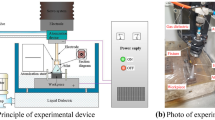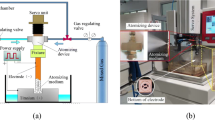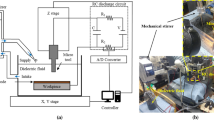Abstract
This paper presents an investigation of the effects of the gas medium on the submersed gas-flushing electrical discharge machining (EDM) of different metal materials. Two metal materials, specifically TC4 titanium alloy and Cr12 steel, are selected as the processing objects, which are immersed in water-based working fluid. The material removal rates (MRRs), relative electrode wear rates, surface morphologies (SMs), and surface recast layers (SRLs) of these two materials during EDM were studied with both air and argon as the gas medium (Air-EDM and Ar-EDM, respectively). The experimental results showed that the MRR of Ar-EDM processing of TC4 is nearly four times that observed using Air-EDM. In contrast, the MRR of Ar-EDM processing of Cr12 is one seventh that found with Air-EDM. At the same time, a relatively thin SRL and an improved SM can be obtained by Ar-EDM with both TC4 and Cr12. During Air-EDM, heat is produced from oxidation reactions, which makes the MRR with Cr12 higher than that with TC4, and the quality of the surface morphology is poor. The results from simulations of single-pulse discharge show that the difference in thermal conductivity between TC4 and Cr12 is responsible for the different material removal rates during Ar-EDM machining.









Similar content being viewed by others
Data availability
The data and materials set supporting the results are included within the article.
Code availability
Not applicable.
References
Kunieda M, Yoshida M, Taniguchi N (1997) Electrical discharge machining in gas. CIRP Ann Manuf Technol 46(1):143–146
Tao J, Shih AJ, Ni J (2008) Experimental study of the dry and near-dry electrical discharge milling processes. J Manuf Sci Eng 130(1):284–284
Govindan P, Joshi SS (2010) Experimental characterization of material removal in dry electrical discharge drilling. Int J Mach Tools Manuf 50:431–443
Kunieda M, Furuoya S, Taniguchi N (1991) Improvement of EDM efficiency by supplying oxygen gas into gap. CIRP Annals—Manuf Technol 40:215–218
Yoshida M, Kunieda M, Kaneko Y (1998) Improvement of material removal rate of dry EDM using piezoelectric actuator coupled with servo-feed mechanism, in: Proceedings CAPE 14: 283–288.
Zhang QH, Zhang JH, Deng JX, Qin Y, Niu ZW (2002) Ultrasonic vibration electrical discharge machining in gas. J Mater Process Technol 129(1–3):135–138
Liqing L, Yingjie S (2013) Study of dry EDM with oxygen mixed and cryogenic cooling approaches. Procedia CIRP 6:345–351
Macedo FTB, Wiessener M, Hollenstein C, Kuster F, Wegener K (2016) Dependence of crater formation in dry EDM on electrical breakdown mechanism. Procedia CIRP 42:161–166
Singh NK, Pandey PM, Singh KK (2017) Experimental investigations into the performance of EDM using argon gas-assisted perforated electrodes. Mater Manuf Process 32(9):940–951
Roth R, Balzer H, Kuster F, Wegener K (2012) Influence of the anode material on the breakdown behavior in dry electrical discharge machining. Procedia CIRP 1:639–644
Yu Z, Jun T, Masanori K (2004) Dry electrical discharge machining of cemented carbide. J Mater Process Technol 149:353–357
Liu ZD, Yin CJ, Chen LH, Qiu MB, Tian ZJ (2014) Efficient combined machining of electrospark-induced controllable combustion and turning dressing for TC4. Mater Manuf Process 29(5):614–620
Kong L, Liu Z, Han Y, Qiu M (2018) Research on the efficient and stable sinking electrical discharge machining ablation process of Ti-6Al-4V. Int J Adv Manuf Technol 97:2151–2161
Shen Y, Liu Y, Zhang Y, Dong H, Sun W, Wang X, Zheng C, Ji R (2015) High-speed dry electrical discharge machining. Int J Mach Tools Manuf 93:19–25
Linglei K, Zhidong L, Mingbo Q (2019) Machining characteristics of submersed gas-flushing electrical discharge machining of Ti6Al4V alloy. J Manuf Process 41:188–196
Chuanjian T, Xiaoming K, Wansheng Z (2008) Experimental study of submersed gas-jetting EDM. Electromachining & Mould 3:16–20
Acknowledgements
The authors extend their sincere thanks to those who contributed in the preparation of the instructions.
Funding
This work is supported by National Natural Science Foundation of China (Grant No. 51675233).
Author information
Authors and Affiliations
Contributions
All authors have been personally and actively involved in substantive work leading to the report.
Corresponding author
Ethics declarations
Ethical approval
Not applicable.
Consent to participate
Not applicable.
Consent for publication
Not applicable.
Conflict of interest
The authors declare no competing interests.
Additional information
Publisher’s note
Springer Nature remains neutral with regard to jurisdictional claims in published maps and institutional affiliations.
Rights and permissions
About this article
Cite this article
Jiang, Y., Ping, X., Zhang, Y. et al. Effects of gas medium on submersed gas-flushing electrical discharge machining of different metal materials. Int J Adv Manuf Technol 115, 2313–2323 (2021). https://doi.org/10.1007/s00170-021-07192-2
Received:
Accepted:
Published:
Issue Date:
DOI: https://doi.org/10.1007/s00170-021-07192-2




